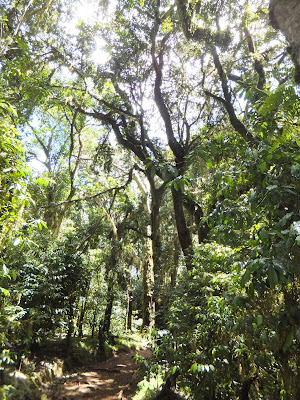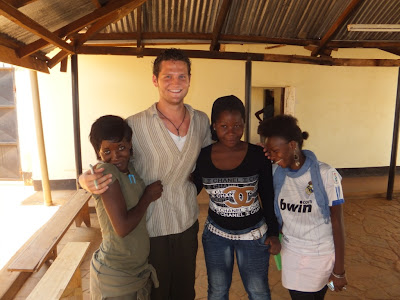 |
| The peak of Kilimanjaro |
Day One: The Trek Begins
In the morning we met our guides and porters and headed to the village of Marangu to begin our climb. We checked in with the national park's rangers and warden and began our adventure and ascent through the rain forests of Mount Kilimanjaro. Unable to see the summit due to the cloud cover, it was hard to comprehend exactly what we had gotten ourselves into.
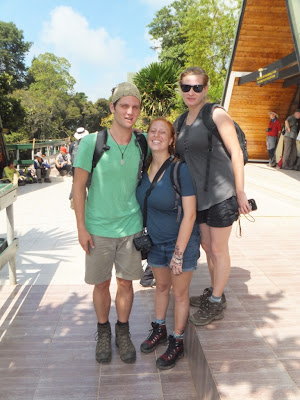 |
| Got our permit and we are clear to climb! Myself, Adriana and Julie |
Hiking through the rain forest was majestic (a word that will repeat throughout this blog) with a sense of nostalgia. Even though the trees were different and the wildlife was exotic, walking through the woods gave me such a feeling of home. My favourite past time consists of a walk through nature with good friends and either great conversation or thought-provoking silence.
During the first day of hiking we met our guides Richard and Filbert. As I climbed I shared great conversation with Filbert getting to know him and what his life looks like as a guide on Kilimanjaro. The others were hiking ahead and I decided to stay the pace of Filbert, who climbs the mountain on a weekly basis. After sharing my story and how I got there, Filbert and another guide began to ask me questions about HIV/AIDS and I found myself spending more valuable time with just a couple more locals continuing the work I set out to do in Tanzania, educating on the people on HIV and the importance of getting tested, taking ARV's, dispelling myths and promoting safe sex.
After two hours we had reached our picnic area for lunch, a small clearing in the woods with a toilet area and a couple picnic tables. As we consumed our boxed lunches and traded our snacks much like school children, I heard a rustle in the woods. I let out a "noise" of shock when I saw behind my new friend Sam, there was a creature coming through the bush with a rat like face and red eyes, only much bigger with large teeth. I yelled to Filbert, looking for those magical words "it's ok, it's just a...", which I was glad to receive only the end of his sentence was "...mongoose but be careful, they bite and not very nice." Although they were quite skittish, we watched as they continued to grow in numbers and strategize how they would get to our food. We escaped the mongoose invasion and met back up with Richard, our head guide, for the final hour of our day.
 |
| Mongoose eyeing up my lunch |
As we were hiking, Adriana expressed that she was a little upset she hadn't seen any monkeys in the rainforest and before I could recount my story of my previous hike through the forest in the Ulugurus, a monkey appeared in a tree to our immediately left, causing quite a startle. Before we could laugh about the coincidence of our conversation and nature, we reached for our cameras and snapped a few photos of the little blue monkey that was greeting us from his branch. As he continued to pose, we continued to take pictures until we were reminded of how far we had to keep hiking for that day.
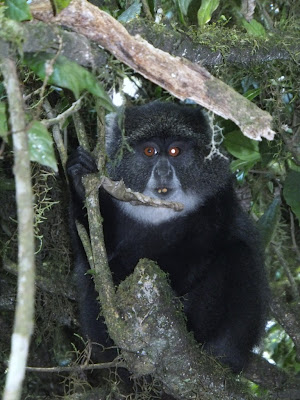 |
| Blue monkey popped out to say hello |
We continued up the trail a little further and reached our first camp; the Mandara Huts at 2723m/8934ft amsl. We settled in to our cabin, a small a-frame with three beds on the floor and one bunk and enjoyed tea with our new British friends, Sam and Marianne.
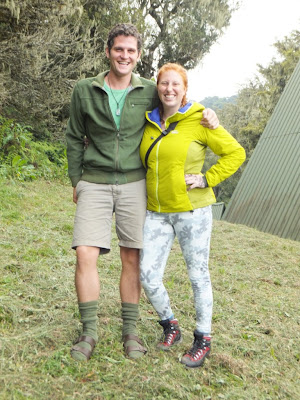 |
| Making fashion faux pas at 9000ft above sea level |
 |
| Black and White Colobus Monkey |
"The woods are lovely, dark and deep,
But I have promises to keep,
And miles to go before I sleep."
- Robert Frost
Day Two: Pole Pole Dada na Kaka
Much like any other day, I was up before everyone else at 5:00am. It was a chilly morning, one like a late autumn day back home but when I walked outside, my breath was taken by the beauty of the sun rising up from beneath the clouds. Adriana and I watched as the sun came up and then quickly returned to our sleeping bags to warm up before we were called for breakfast.
Following our breakfast and tea, we packed our bags and began hiking our last leg through the rainforest. As we left the forest behind us we quickly got a glimpse of both sister peaks of Mount Kilimanjaro, Mwenzi and Kibo. It finally put things in perspective. I was awestruck.
We hiked for 3 hours, "pole pole" (slowly), until we reached our lunch area at 11,000ft amsl. All I could think was , "so far so good." We had passed the 10,000ft point and although you could feel the lack of oxygen, and it would only get worse, none of us were feeling ill at this point. Adriana and I took the last part of our day hiking very slowly with Filbert. As we trekked, he pointed out different shrubs, plants, flowers and wildlife that were unique to Kilimanjaro and at some points made it feel like we had left planet Earth.
 |
| White Necked Raven of Kilimanjaro |
 |
| Lobelia Trees of Kilimanjaro |
"Slow is smooth, and smooth is fast."
- Phil Dunphy
The cloud cover continued to grow until we could barely see more than ten feet in front of us. We could hardly see the huts in the distance but they were there and we reached them "faster" not having to watch them slowly get closer and closer.
 |
| Homboro Huts - 12,208ft above sea level |
Feeling a little nauseas after dinner I was happy to just rest in my sleeping bag and get to know Sam and Marianne who had joined our cabin for the night. After taking a Gravol however, I drifted quickly out of the conversation and into lala land.
Day Three: Crossing the Saddle
Once again, the early bird caught the most glorious worm. I was up to see another spectacular sunrise above the clouds at 12,208ft amsl. It was too breathtaking to not wake the others and drag them out to see it. After we spent a while admiring the sheer beauty of the moment, it was time for breakfast. Today was going to be a challenging day and we had a lot of mountain to cover in a short period of time.
 |
| Sun rise at the Homboro Huts |
We began our hike through the last pieces of the moorlands, leaving all vegetation behind. Hiking ever so slowly, we enjoyed the best views yet of Kibo and Mwenzi as we reached the saddle between the two peaks. It was magnificent. The two sister peaks, side by side, with a swooping saddle of tundra connecting them. As we passed the sign that read "Last Water Point" my anxiety level rose in both meanings of the word. Never had I hiked so high to reach a point of no water, which makes you fear the unknown and yet the pride of making this far only made be more motivated to reach the top!
 |
| Kibo - Saddle - Mwenzi |
 |
| This picture speaks for itself... |
After a quick lunch with the Kilimanjaro Four-Striped Mice, which one might assume was the offspring of a grass mouse and a chipmunk, we continued traversing the saddle and made a final ascent to the Kibo Huts at 15,466ft amsl at around 3:00pm. Everyone at this point was feeling the lack of oxygen and your body constantly reminded you of that. You begin to relax when sitting down for dinner but when you try to "hurry" to the outhouse, you are quickly reminded of the altitude with light-headedness, nausea, headaches, and spotty vision.
 |
| Four-striped mouse |
Day 4: Summit or Bust
I didn't sleep a minute during the time we had but the rest of the group awoke at 11:00pm as planned and we all put on as many layers as we had and all of our winter gear with our headlamps acting as the finishing touch. Richard and Filbert came to get us shortly after and we began our trek as scheduled at midnight. The stars were mesmerizing and you could not help but to stare straight up at them as we left camp. While you could not see the peak or the people in front of you, the glow of the moon on the snow gave an ambiance of light to our journey. As I looked for the peak, which I knew was the shadow of darkness, void of stars, I saw a falling star streak downwards and disappear in the dark. I made not so much a wish but a promise to myself that I would reach the summit that night.
As we started walking, I made sure I started my breathing pattern. Slow, smooth breaths with each step I took, taking a deep breath every five feet or so. We started to head up the slope, which you could feel but you couldn't see. All I could see was Adriana's feet in front of me with my headlamp.
About an hour into the climb Adriana felt ill and turned back. As she left, she told me to "keep going, you can do it." With that we left her in the company of Filbert and back into the darkness they would descend to the Kibo huts where she would be able to rest. People began to ask the guides questions like, "how much longer?" and "can we stop for a break?" but all I could do was keep quiet and focus on my trek, visualizing myself at the summit with that notorious sign of victory that red "Congratulations, you have reached Uhuru Peak."
During our break at the Hans Meyer Cave (17,254ft.) there were quite a few people beginning to get increasingly ill, and unfortunately, soon after, Julie made the trip back to the Kibo huts with our guide Richard. Left with the guides of our new friends Sam and Marianne, Duncan and I continued to trek up the steep slope of Kibo.
As we hiked, I would look down the slope every once in a while to see the majestic view of small headlamps in small groups criss-crossing and ascending the mountain behind us. At one point, soon after the halfway point, I noticed one lamp was passing the others. As it got closer, I heard someone call my name. "Mambo, Beni?" It was Filbert! He had taken Adriana back to the huts and returned to help Duncan and I reach the summit. My drive and motivation was strengthened with the return of a trusted friend and as he took the lead of our dwindling group, he shot me a smile and a wink, as if to stay"good job, keep going."
As we continued hiking, step by step, Filbert would check in with me to see how I was doing. As we neared the top of the crater, we had passed all other guides and hikers and with fresh fallen snow, there was no path to follow up over the rock face. On hands and knees, Filbert led the way to reach Gillman's Point at 4:46am (18,763ft amsl). Technically, once you have reached Gillman's point, you have reached the top of the mountain but Uhuru Peak is the official summit.
After a quick break for water, Filbert got Duncan and I to start trekking the edge of the massive black crater in hopes to reach the true summit by sunrise. With my visual of me at the sign, and the immense feeling of pride that would accompany summitting, I ignored my lack of oxygen, splitting headache (understated), increased heart rate and exhausted body.
 |
| View of Mwenzi peak from Kibo |
As the sun rose, the views at every slow blink changed and were all so beautiful but it was the view of the new sign that made everything worthwhile. Although I had envisioned myself standing under the old wooden sign when I reached the summit, I was just as happy to read and stand beside the new one.
"Congratulations!
You are now at Uhuru Peak
5895m AMSL
Tanzania
Africa's Highest Point
World's Highest Free Standing Mountain"
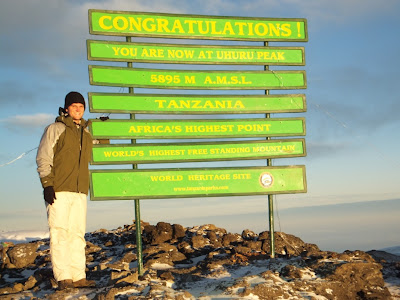 |
| The million dollar picture! |
 |
| Filbert and I with the new sign at the summit of Kibo - Mount Kilimanjaro |
After taking our pictures with the sign it was time to descend. The weather is unpredictable at the top and can change very quickly. Filbert led us back around the crate to Gillman's point and we began our descent. When I reached the Kibo huts I was so happy to rejoin my two girls and our Brits for some juice and breakfast. After a short rest we had to begin the descent to the Homboro Huts, where we would sleep the night.
Day Five: Final Descent
Back across the moorlands and down through the rainforest we finished out five day trek in torrential rain. Although it would be easy to complain that we were soaked through from the rain, Adriana and I spent our time thinking positively of our climb and the rain.We checked back in at the ranger station and the warden issued certificates to those who summitted.
After a nice comfortable van ride back to the hotel, we said thank-you to our guide Richard and spent some time with Filbert (over a Kilimanjaro Lager, or two) before giving our final goodbyes.
I have never accomplished such a challenge in my life. Kilimanjaro, although a non-technical climb challenges you physically but also mentally. I used to mock those black posters you see in schools and offices with the one powerful word in bold white print, like "Motivation," "Effort," or "Accomplishment" and yet now I understand exactly what they mean. Imagine one of those posters with a man hanging from the edge of a cliff, it might seem silly to equate the man's challenge scaling a rock face to your own but that is not what it is about. Whether your challenge is finishing a project, climbing a mountain or living with a disability, as a visible minority, or with a positive HIV status, you have the right to feel all of those same feelings and emotions without people belittling your efforts and accomplishments.
Pride; Motivation; Leadership; Accomplishment; Life; Air; Success; Achievement; Strength; Determination; Patience; Inspiration. I repeated these words to myself as I climbed, visualizing myself reaching my goal and I did.
May you accomplish any goal you set out to do.
"Whether you think you can or you think you can't, you're right"
- Henry Ford
